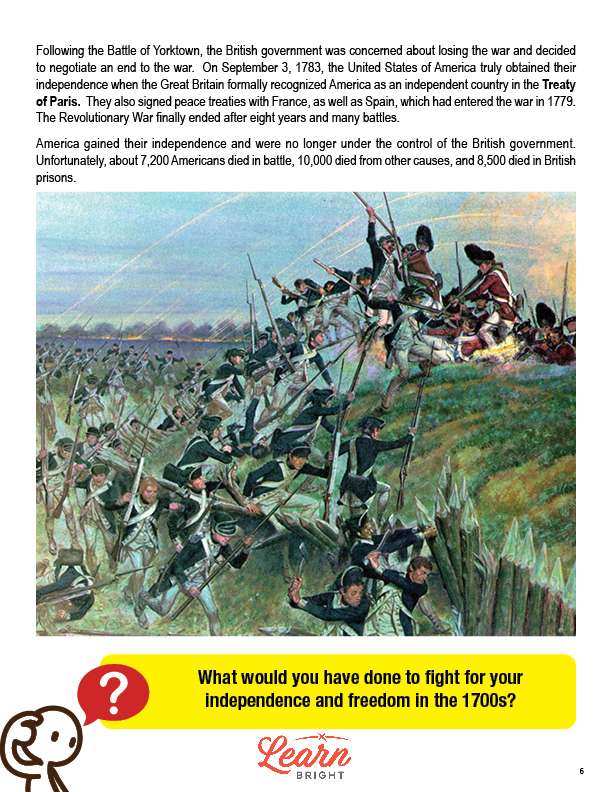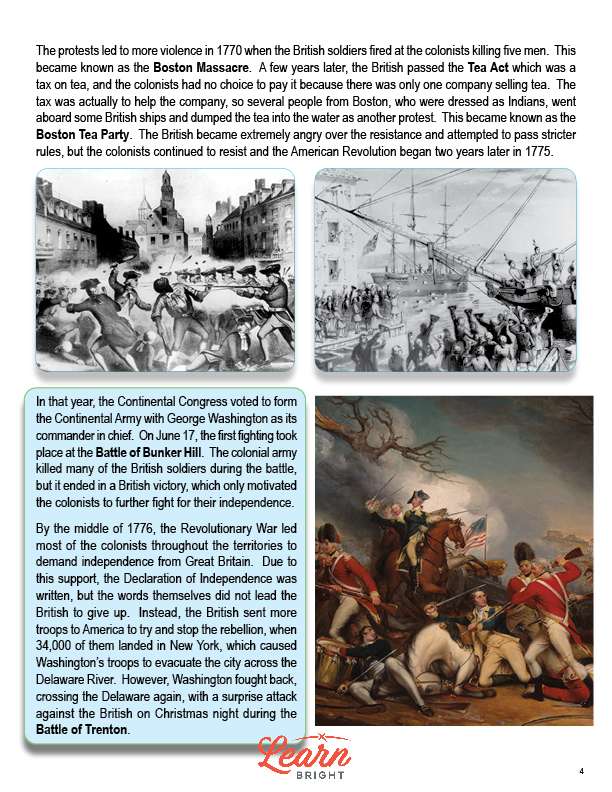Description
What our Revolutionary War lesson plan includes
Lesson Objectives and Overview: Revolutionary War introduces students to the Revolutionary War, including some causes and effects and related vocabulary. At the end of the lesson, students will be able to explain the causes of the Revolutionary War, identify some of the major events, battles, and people, and define some of the terms related to the war. This lesson is for students in 4th grade, 5th grade, and 6th grade.
Classroom Procedure
Every lesson plan provides you with a classroom procedure page that outlines a step-by-step guide to follow. You do not have to follow the guide exactly. The guide helps you organize the lesson and details when to hand out worksheets. It also lists information in the orange box that you might find useful. You will find the lesson objectives, state standards, and number of class sessions the lesson should take to complete in this area. In addition, it describes the supplies you will need as well as what and how you need to prepare beforehand. To prepare for this lesson ahead of time, you can copy the handouts and make sure your students can access the internet.
Options for Lesson
Included with this lesson is an “Options for Lesson” section that lists a number of suggestions for activities to add to the lesson or substitutions for the ones already in the lesson. If you’d like to adjust the lesson activity, you can have students work alone and assign one event, battle, or person to each student. An optional addition to the activity is to have students also create a full written report for the battles, events, or people. You could also assign the puzzle as in-class work. Finally, you can use the videos from the additional resources as supplemental materials for students to get more information for their assignments.
Teacher Notes
The teacher notes page includes a paragraph with additional guidelines and things to think about as you begin to plan your lesson. This page also includes lines that you can use to add your own notes as you’re preparing for this lesson.
REVOLUTIONARY WAR LESSON PLAN CONTENT PAGES
Revolutionary War
The Revolutionary War lesson plan includes four pages of content. The lesson begins by explaining that Independence means freedom from the control of others. In the late 1700s, the colonists in America wanted their independence from Great Britain. Because of this, Thomas Jefferson wrote the Declaration of Independence in 1776. This document did not give the colonists immediate freedom, but did contribute to Revolutionary War, which began in 1775. We sometimes call the Revolutionary War the American Revolution, the American Revolutionary War, or the U.S. War of Independence.
Many different factors led to the Revolutionary War. The British tried to overtax the colonists. The colonists then protested against the British in 1770 because the British forced them to give money to the British government without being able to vote or have a say in the government. They called this taxation without representation. It would be like if you chose not to join a local club that cost $5, but they forced you to pay some money anyway!
British soldiers fired at the colonists during these protests and killed five people, an event that we call the Boston Massacre. The British passed the Tea Act a few years later, which implemented a tax on tea. The colonists had to pay the tax because the British had the only company that sold tea. People from Boston then dressed up as Native Americans and dumped the tea into the water of the Boston Harbor in protest. We call this event the Boston Tea Party. The British didn’t like this and tried to pass even stricter rules. The colonists kept resisting. Two years later, in 1775, the American Revolution began.
The First Battle
That year, the Continental Congress voted to create an army with George Washington acting as the commander in chief. The first fight of the war, the Battle of Bunker Hill, happened on June 17. The colonial army killed lots of British soldiers, but the British ultimately won. This motivated the colonists to fight even harder.
By mid-1776, most people living in the colonies demanded independence. Jefferson wrote the Declaration of Independence to capitalize on their support. The British did not give up, and sent more troops to America to try to stop the revolutionary. 34,000 British troops landed in New York and Washington evacuated his troops across the Delaware River. Washington fought back, crossed the Delaware, and led a surprise attack against the British at the Battle of Trenton.
More battles took place in 1777 and 1778, like the Battles of Princeton, Germantown, Brandywine, Saratoga, and more. In winter 1777, Washington and his troops struggled to survive the weather at Valley Forge. The troops became stronger.
The Americans defeated the British and changed the tide of the war at the second Battle of Saratoga in Saratoga, New York. The French then joined the American’s side in the war. At this time, the French had already been helping the Americans secretly for a year. France officially declared war on Great Britain in June 1778.
After this battle, Washington and his troops attacked the British troops trying to travel to New York from Philadelphia. This battle ended in a draw, with both sides deadlocked.
From 1779 to 1781, the Americans had some losses. An American general, Benedict Arnold, defected. This means that he became a traitor and switched sides to fight for the British instead. His name, to this day, makes people think of traitors.
The war started to come to an end between 1781 and 1783. The British won some battles, but the Americans overcame this. The French helped them during the Battle of Yorktown, and surrounded the city. The French navy attacked the British in the Chesapeake Bay and bombed the British troops on land. The British troops surrendered on October 18, 1781.
After the Battle of Yorktown, the British government became concerned about losing and wanted to negotiate to end the war. The United States gained their independence on September 3, 1783, when Great Britain formally recognized the United States as an independent country with the Treaty of Paris. The British also signed peace treaties with France and Spain. After eight years, the Revolutionary War ended.
America became independent and weren’t under Great Britain’s control anymore. During the war, about 7,200 Americans died in battle, 10,000 died from other causes, and 8,500 died in British prisons.
REVOLUTIONARY WAR LESSON PLAN WORKSHEETS
The Revolutionary War lesson plan includes two worksheets: an activity worksheet and a homework assignment. You can refer to the guide on the classroom procedure page to determine when to hand out each worksheet.
REVOLUTIONARY WAR ACTIVTY WORKSHEET
Students will work with a partner to complete the activity worksheet. Each pair of students will research one or two major events, battles, or people from the Revolutionary War, as assigned by the teacher. They will present their research to the class, including a short summary of the battle, event, or person.
CROSSWORD HOMEWORK ASSIGNMENT
For the homework assignment, students will complete a crossword puzzle using Revolutionary War vocabulary words.
Worksheet Answer Keys
This lesson plan includes answer keys for the homework assignment. If you choose to administer the lesson pages to your students via PDF, you will need to save a new file that omits these pages. Otherwise, you can simply print out the applicable pages and keep these as reference for yourself when grading assignments.









